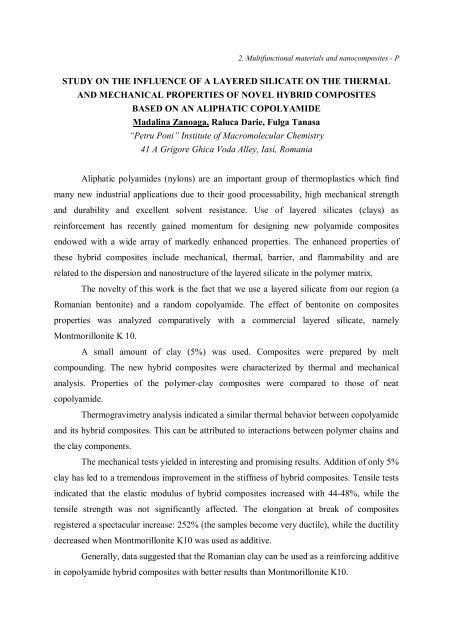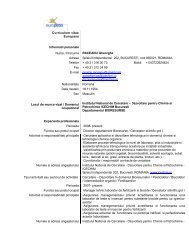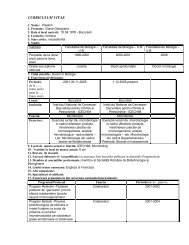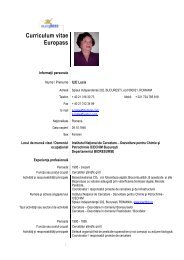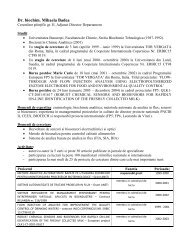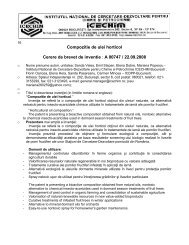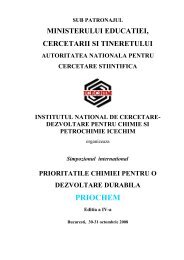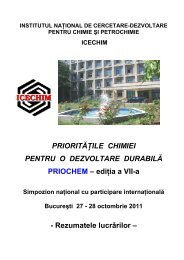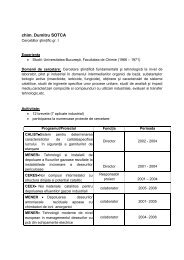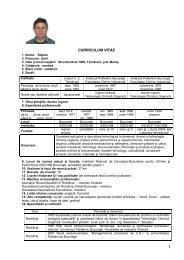INSTITUTUL NAÅ¢IONAL DE CERCETARE-DEZVOLTARE - ICECHIM
INSTITUTUL NAÅ¢IONAL DE CERCETARE-DEZVOLTARE - ICECHIM
INSTITUTUL NAÅ¢IONAL DE CERCETARE-DEZVOLTARE - ICECHIM
- No tags were found...
You also want an ePaper? Increase the reach of your titles
YUMPU automatically turns print PDFs into web optimized ePapers that Google loves.
2. Multifunctional materials and nanocomposites - PSTUDY ON THE INFLUENCE OF A LAYERED SILICATE ON THE THERMALAND MECHANICAL PROPERTIES OF NOVEL HYBRID COMPOSITESBASED ON AN ALIPHATIC COPOLYAMI<strong>DE</strong>Madalina Zanoaga, Raluca Darie, Fulga Tanasa“Petru Poni” Institute of Macromolecular Chemistry41 A Grigore Ghica Voda Alley, Iasi, RomaniaAliphatic polyamides (nylons) are an important group of thermoplastics which ndmany new industrial applications due to their good processability, high mechanical strengthand durability and excellent solvent resistance. Use of layered silicates (clays) asreinforcement has recently gained momentum for designing new polyamide compositesendowed with a wide array of markedly enhanced properties. The enhanced properties ofthese hybrid composites include mechanical, thermal, barrier, and flammability and arerelated to the dispersion and nanostructure of the layered silicate in the polymer matrix.The novelty of this work is the fact that we use a layered silicate from our region (aRomanian bentonite) and a random copolyamide. The effect of bentonite on compositesproperties was analyzed comparatively with a commercial layered silicate, namelyMontmorillonite K 10.A small amount of clay (5%) was used. Composites were prepared by meltcompounding. The new hybrid composites were characterized by thermal and mechanicalanalysis. Properties of the polymer-clay composites were compared to those of neatcopolyamide.Thermogravimetry analysis indicated a similar thermal behavior between copolyamideand its hybrid composites. This can be attributed to interactions between polymer chains andthe clay components.The mechanical tests yielded in interesting and promising results. Addition of only 5%clay has led to a tremendous improvement in the stiffness of hybrid composites. Tensile testsindicated that the elastic modulus of hybrid composites increased with 44-48%, while thetensile strength was not significantly affected. The elongation at break of compositesregistered a spectacular increase: 252% (the samples become very ductile), while the ductilitydecreased when Montmorillonite K10 was used as additive.Generally, data suggested that the Romanian clay can be used as a reinforcing additivein copolyamide hybrid composites with better results than Montmorillonite K10.


